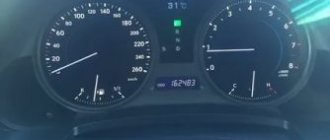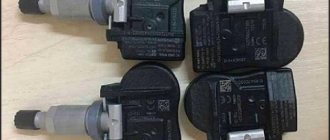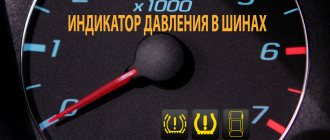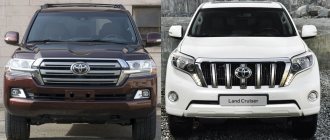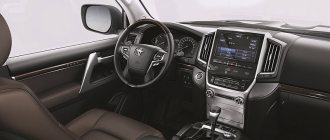Good day to all!
When I installed new wheels with 305/50 R20 tires instead of the standard 285/60 R18, the tire pressure was adjusted according to the instructions. True, the required tire size was not indicated in the operating manual, so I took the pressure for tires 285/50 R20 as a basis - 2.4 atmospheres.
As I already described in the BZ (corresponding topic), the emotions from using the new wheels and tires were extremely positive, and emphasized the right choice when deciding to replace them. However, what is there to hide, I couldn’t shake the feeling that despite all the advantages of such a replacement, something was still missing... namely, it was a little lacking in softness. However, I was ready for this, because such a replacement is always a compromise, but the desire to experiment with tire pressure did not leave me. Moreover, when leaving the parking lot in the morning, something desirable in Kruzachk’s behavior seemed to be present, but then disappeared somewhere rather quickly.
It is clear that the reason was the tire pressure. Using standard tire pressure sensors, I noticed that when driving around the city, tire pressure increases by an average of 0.3 - 0.4 atmospheres, and even more in hot weather. And then Kruzachok feels all the irregularities and joints and becomes quite rigid.
And finally, last weekend I had some free time to bring my idea to life. During the day, when the sky was cloudy, I set the pressure in all tires to 2.2 atmospheres. The calculation was that by lunchtime the air in the tires had warmed up a little, and after parking overnight it should be about 0.2 atmospheres lower. And so it happened... now, when I get into the car in the morning, the sensors show a pressure of 2.0 atmospheres. And after some time it increases to 2.1 - 2.2 atmospheres. Without exaggeration, I can safely say that Kruzachok’s behavior has become completely different - exactly the way I wanted!
Joints, cracks, holes, irregularities - you simply don’t notice them! At the same time, in the morning, when the pressure after an overnight stay is minimal, the tires do not even look flat, and there is no increase in fuel consumption. I am sure that the tires will not wear out quickly... but this will only be confirmed after some time.
I deliberately rode for almost two weeks before creating this recording to make sure that these were not just emotions, but real sensations. Now I am 100% satisfied with the replacement of wheels and tires... no, even 200%!
Not only your driving comfort and fuel consumption, but also your safety on the road depend on the pressure in your vehicle tires. Therefore, you need to keep this indicator under control. Below we will look at how to correctly measure the pressure in the tires of the Toyota Land Cruiser 200 and other models of this brand.
Measuring pressure in car wheels
Pressure measurement methods
It is almost impossible to obtain accurate data without special partings. You can only visually diagnose incorrect pressure in the tires of a Toyota Land Cruiser 200. If it is in the tires systematically, the tread pattern will change.
You can correctly and, most importantly, accurately measure the air level in a Toyota Land Cruiser 200 (the same applies to the Camry, Rav, and Corolla models) using pressure gauges.
Today there are two types of pressure gauges:
Toyota Rav4 tire pressure sensor
On a note.
Similar car models are already produced from the factory with a built-in TPMS system.
This is a system that automatically measures tire pressure and transmits the readings to the instrument panel. Each tire has a built-in air valve sensor. It is powered by a lithium battery that has a shelf life of approximately ten years. Such a sensor cannot be twisted and stolen, which cannot be said about mechanical controllers that are screwed into the nipple. The advantages of electronic built-in measuring instruments include:
- reliability;
- impossibility of theft;
- efficiency;
- safety.
Nowadays, such control systems are new and they are only gaining popularity. But in the USA they are already a mandatory attribute of a car, comparable to seat belts. They are able to signal not only about low tire pressure, but also about a puncture and overinflation of the tire.
Optimal pressure parameters are set before starting the system.
And if the device notices any deviations from the specified indicators, the system signals this. But like any electronics, it is capable of failure. And in this case, the driver has to constantly watch the annoying flashing light on the instrument panel. The indicator may light up in the following situations:
- with a sharp change in temperature;
- when changing a wheel;
- when replacing all wheels;
- when there is an air leak.
You may be interested in this Pirelli - review of winter tires
The error can be cleared by simply resetting all settings. To do this, you will need to turn on the ignition, but do not start the engine. There is a SET button under the steering wheel; press and hold it for a couple of seconds. After this, the indicator will start flashing. When the flashing stops, you need to start the car for a couple of minutes. In this way, you can remove the error from the system on Toyota Rav 4 and reboot the system.
Note!
Some pressure monitoring systems can transmit readings directly to the owner's smartphone via Bluetooth.
Tire pressure gauge
Correct pressure measurement
The amount of air in car tires must be measured, taking into account the following rules:
- Measurements should only be taken with unheated tires;
- Pressure readings should be taken from four wheels, not just one;
- The pressure is measured only after the machine is completely stationary.
Only in this case can the indicators produced by the device be considered correct.
Standard tire pressure for Toyota Camry
Load Index
This parameter expresses in numbers the maximum load that the tire can withstand at the speed indicated by the index and at a certain air pressure in it.
If you don’t want to overload your favorite car, calculate its load index. Do you think it doesn't matter? You are very mistaken. Do you think it's difficult? Not at all. The calculations are simple and anyone can do them.
To calculate the maximum load that can be placed in a car, you need to add up the load of all the wheels and then subtract the weight of the loaded car.
Consequences of incorrect pressure
At the same time, it should be noted that systematically incorrect pressure can lead to negative consequences. This is true for both shortage and excess air in the tires.
The most common malfunctions in vehicle operation are:
- tire deformation;
- inappropriate fuel consumption;
- wheel eversion.
In addition, it should be noted that incorrect pressure can lead to incorrect behavior of the car while driving, which in itself is unsafe.
Standard tire pressure for Toyota Corolla
Pressure measurement process
As already mentioned, measurements should only be taken on “cold” machines. This means that in the last 3 hours the car should have traveled no more than 1.5 kilometers.
The valve cap located on the wheel must be unscrewed and a pressure gauge must be immediately attached.
Standard tire pressure for Toyota Rav4
As a rule, the table with the parameters is attached to the driver's side door or on the gas tank cap. If for some reason there is none, the tables can be viewed online. In this case, you should take into account that the data in the table may differ slightly from those established by the manufacturer.
Please note that you need to measure indicators in a Toyota Cruiser 200 or Rav on all wheels, including the spare. This is the only way to obtain a complete and reliable picture of the pressure state in the wheelbase.
Whatever car you have (Toyota Rav, Lada, VAZ or any other), the air level in the tires plays a major role in the overall performance of the car.
The best option is to measure tire pressure regularly before and after driving. If it is often not possible to carry out such manipulations, monthly inspections should be carried out at a service station. A car that is operated correctly will serve its owner for a long time, reliably and, most importantly, safely.
"Kruzak" is a dream car. It is impossible to explain such interest in this car otherwise. The tire pressure of the Toyota Land Cruiser 200 affects the vehicle's performance, fuel consumption and other parameters important for the driver.
Optimal pressure
According to the manual, the optimal tire pressure for the Land Cruiser 200 is 2.3-2.4 atmospheres. The car weighs a lot, and in order to withstand its weight, the manufacturer recommends inflating the tires so much.
At the same time, TLK owners note that with such pressure, road unevenness is felt much more strongly, and the wheels themselves are noticeably noisy. Therefore, they prefer to stop at 2.2 atmospheres. With this pressure indicator, the car moves softer, but does not lose control.
Particular care should be taken when inflating tires at a service station. For most modern cars, the recommended pressure is 2.0, because of this, mechanics often don’t bother and pump the Kruzak tires in the same way. Yes, the car rides even smoother on flat tires, but the tires wear out much faster, the likelihood of disc destruction increases and fuel consumption increases.
The manufacturer attaches a sign with recommended inflation parameters to the inside of the gas tank cap or driver's door.
Opinion about pressure pumping from other owners
Sergey, 34 years old.
I have owned a Kruzak 200 for three years and use 20-diameter wheels, because they have proven to be better than others, especially on our roads. I pump them up as recommended by the manufacturer - up to 2.4 atmospheres and I must say that this is a completely universal pressure. I feel comfortable when driving in the city and outside.
Anton, 41 years old.
Prado has been my favorite model for many years, now I’m driving the second generation. It is important to follow the manufacturer's recommendations, but you can be a little flexible and increase the pressure a little. On the recommendation of other owners, I drive 2.4 atmospheres on the front and rear tires and am satisfied.
Vadim, 38 years old.
I've wanted a Land Cruiser 200 for a long time. Not least because of its powerful appearance, in which large wheels play a special role. The main thing is that they are huge not for beauty, but because Kruzak is able to drive where not everyone can. For off-road driving, I keep the pressure at 2.3 atmospheres on 18-diameter ramps.
Specialization : Graduated from the State Automobile University, worked for 20 years at GAZ-56, now I drive a Zhiguli.
Source
Consequences of incorrect pressure
It is worth noting that tire pressure is not constant: it changes depending on temperature. In summer, it increases during the day: 2.0 atmospheres after several hours of driving on hot asphalt will turn into 2.2. In winter, the process is reversed: as temperatures drop, the pressure in the tires will also decrease. If you stay within the established parameters, even such changes in atmosphere will not be noticeable.
But due to pressure that is too far from normal, the car's behavior may change.
| Overpressure | Insufficient pressure |
| Ride stiffness | Deterioration of road grip |
| Deterioration of road grip | Rapid tire wear |
| Increased load on the body and chassis | Rolling deterioration |
| High risk of rubber damage | Increased fuel consumption |
| Noise | Increased risk of tire failure |
| Uneven tire wear | Reduced controllability |
Each of these factors is a risk to road safety.
The deviation from the tire inflation parameters recommended by the vehicle manufacturer should not exceed 20%.
Tire sizes
Toyota Land Cruiser 200 comes with 3 wheel sizes: 17, 18 and 20 inches.
| R17 | R18 | R20 | |
| Disc width | 8 | 8 | 8.5 |
| Departure | 60 | 60 | 60 |
| Tire markings | 285/65 R17 116H | 285/60 R18 116V | 285/50 R20 112V |
| Width | 285 mm | 285 mm | 285 mm |
| Profile | 65% | 60% | 50% |
| Load Index | 116 (cargo weight up to 1250 kg) | 116 (up to 1250 kg) | 112 (up to 1120 kg) |
| Speed index | H (speed up to 210 km/h) | V (up to 240 km/h) | V (up to 240 km/h) |
The tire parameters indicated in the table are only recommendations from the manufacturer - some car owners allow experiments with them.
You can change both the pressure in the wheels of the Toyota Land Cruiser 200 and the tire sizes themselves.
Width
Car owners prefer wide tires - with them the car looks much more impressive:
| Advantages | Flaws |
| Improved handling at high speed | Increased wheel weight |
| Increasing sustainability | Increased load on the chassis |
| Acceleration acceleration | High probability of aquaplaning |
| Shortening the braking distance | Increased fuel consumption (diesel and gasoline) |
| Deterioration of controllability and lengthening of the braking distance on a wet road |
Narrow tires are used because of their low cost and reduced vehicle maintenance costs:
| Advantages | Flaws |
| Reducing the likelihood of hydroplaning | Reduced handling at high speed |
| Reducing wheel weight | Reduced stability |
| Improved rolling | Slow acceleration |
| Simplified steering | Extending the braking distance |
| Reduced fuel consumption | |
| Reducing the influence of ruts |
According to popular belief, narrow tires make a car less attractive in appearance.
Profile
Changing the height of the rubber profile (it is expressed as a percentage) affects handling, ride softness, and braking.
A minimal increase in the profile will make the movement of the car smoother and more comfortable, but the car’s handling will not be affected. If you install tires whose profile is much higher than the established norm, this will primarily affect the weight of the car. Due to its increase, the following will happen:
- decreased controllability;
- increased likelihood of drifts;
- shortening the braking distance;
- increased fuel consumption;
- rapid wear of the chassis.
In addition, a tire that is too massive will scratch the body when driving.
By slightly reducing the profile recommended by the manufacturer, you can achieve better car handling and a shorter braking distance. If tires are installed that are noticeably smaller than the specified parameters, then:
- ride stiffness will increase;
- the load on the chassis will increase;
- the likelihood of tire damage will increase;
- fuel consumption will increase.
No one forbids experimenting with your profile, but you need to do it wisely.
Load Index
The load index shows how much vehicle weight the tires can support without harm. This parameter is indicated by a two-digit number (from 62 to 125), corresponding to the maximum possible load.
To understand how much cargo can be placed in a car, add up the load of all tires (usually tires on cars have the same load, so it is enough to multiply the known number by 4) and subtract the weight of the loaded car.
For the LC 200 on 17- and 18-inch wheels, these calculations look like this:
- 1250 * 4 = 5000 kg - maximum load supported by tires.
- 2585 kg - curb weight of the SUV.
- 5000 – 2585 = 2515 kg - maximum cargo weight.
By analogy, 20-inch wheels can carry 1895 kg.
Speed index
This parameter indicates the maximum permissible speed of the vehicle at full load. The manufacturer guarantees that on a good road and in favorable weather conditions the car can drive at this speed for several hours.
For roads with holes and potholes, it is recommended to select tires with a high index, even if you don’t drive recklessly - such tires are more wear-resistant. Testing the strength of wheels by driving at maximum speed is dangerous: it is better to move a little slower than allowed.
Pressure measurement process
It is recommended to monitor the pressure that should be in the Toyota Land Cruiser 200 tires before each trip. But usually drivers do this once a month or even less often.
Modern cars, including TLC, are equipped with electronic sensors that monitor the condition of the tires. If the system considers that the current reading is different from the standard, the corresponding icon will light up on the dashboard. You can change the value that the sensor considers as a reference using the button located behind the handles that open the hood and gas tank.
A pressure gauge - a device for measuring pressure - is found on all pumps, which allows you to monitor the number of atmospheres during the pumping process. Manual pressure gauges (mechanical and electronic) are inserted into the nipple.
You can only check the pressure on cold wheels. At least 5 hours must pass from stopping the car to measuring - during this time the air will no longer be exposed to temperature. Check all 4 tires at once, otherwise you may not notice that one of the wheels is deflated.




